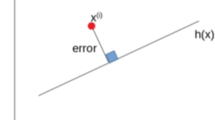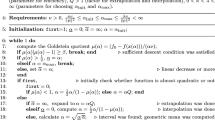Abstract
We present an algorithm for the on-line learning of linear functions which is optimal to within a constant factor with respect to bounds on the sum of squared errors for a worst case sequence of trials. The bounds are logarithmic in the number of variables. Furthermore, the algorithm is shown to be optimally robust with respect to noise in the data (again to within a constant factor).
Similar content being viewed by others
References
S. S. Agaian,Hadamard Matrices and Their Applications. Number 1168 in Lecture Notes in Mathematics. Springer-Verlag, 1985.
E. J. Bernstein, Absolute error bounds for learning linear functions on line.Proceedings of the 1992 Workshop on Computational Learning Theory, 1992, 160–163.
A. Blum, L. Hellerstein, and N. Littlestone, Learning in the presence of finitely many or infinitely many irrelevant attributes.The 1991 Workshop on Computational Learning Theory, 1991, 157–166.
N. Cesa-Bianchi, P. M. Long, and M. K. Warmuth, Worst-case quadratic loss bounds for a generalization of the Widrow-Hoff rule.The 1993 Workshop on Computational Learning Theory, 1993, 429–438.
R. O. Duda and P. E. Hart,Pattern Classification and Scene Analysis. Wiley, 1973.
D. Haussler, Learning conjunctive concepts in structural domains.Machine Learning 4(1) (1989), 7–40.
M. Kearns, M. Li, L. Pitt, and L. G. Valiant, On the learnability of boolean formulae.Proceedings of the 19th Annual Symposium on the Theory of Computation, 1987, 285–295.
S. Kullback, A lower bound for discrimination in terms of variation.IEEE transactions on Information Theory 13 (1967), 126–127.
N. Littlestone, Learning quickly when irrelevant attributes abound: a new linear-threshold algorithm.Machine Learning 2 (1988), 285–318.
N. Littlestone,Mistake Bounds and Logarithmic Linear-threshold Learning Algorithms. PhD thesis, UC Santa Cruz, 1989.
N. Littlestone and M. Warmuth, The weighted majority algorithm.Information and Computation (1994). To appear.
J. Mycielski, A learning algorithm for linear operators.Proceedings of the American Mathematical Society 103(2) (1988), 547–550.
L. Pitt andM. K. Warmuth, Prediction preserving reducibility.Journal of Computer and System Sciences 41(3) (1990), 430–467.
G. Strang,Linear Algebra and its Applications. Harcourt, Brace, Jovanovich, 1988.
B. Widrow and M. E. Hoff, Adaptive switching circuits.1960 IRE WESCON Convention Record (1960), 96–104.
Author information
Authors and Affiliations
Rights and permissions
About this article
Cite this article
Littlestone, N., Warmuth, M.K. & Long, P.M. On-line learning of linear functions. Comput Complexity 5, 1–23 (1995). https://doi.org/10.1007/BF01277953
Received:
Issue Date:
DOI: https://doi.org/10.1007/BF01277953
Key words
- Machine learning
- computational learning theory
- on-line learning
- linear functions
- worst-case loss bounds
- adaptive filter theory




